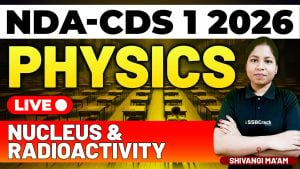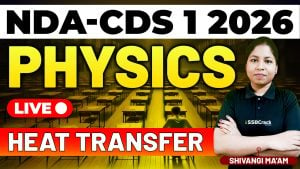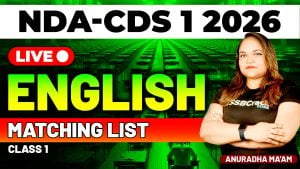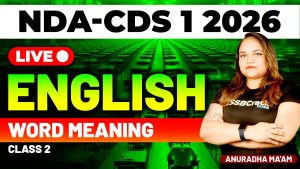The topic of Functions is a fundamental part of the National Defence Academy and Naval Academy (NDA-NA) Exam – Paper I (Maths). Recently, a class was conducted that explored the essential sub-topics of Functions, including their types, inverse, and composition. This session provided students with a strong understanding of these concepts and their applications, particularly in the multiple-choice questions (MCQs) that are often seen in the NDA-NA exam.
In this blog, we will break down the key concepts discussed in the class and explore effective strategies to prepare for the topic of Functions in the NDA-NA exam.
Class Recap: Understanding Functions and Their Properties
Functions are a fundamental concept in mathematics that describe relationships between sets. During the class, students were introduced to the definition of functions, various types of functions, and key operations like finding the inverse and composition of functions. Let’s explore these topics in more detail.
1. Definition of a Function
A function is essentially a relationship that assigns each element from one set, called the domain, to exactly one element in another set, called the range. Understanding this basic definition is crucial, as many problems in the NDA-NA exam focus on identifying and working with functions.
The class emphasized the importance of recognizing whether a given relation qualifies as a function. For instance, a function ensures that no two different elements from the domain are mapped to the same element in the range. This concept is tested in a variety of ways in exam questions.
2. Types of Functions
The class covered several different types of functions, each with its own properties and characteristics. These types are often asked in MCQs, making it essential to be familiar with their definitions and examples.
- One-to-One Function (Injective): In this type, each element of the domain is mapped to a unique element of the range. There are no repeated outputs for different inputs.
- Onto Function (Surjective): Here, every element of the range is associated with at least one element from the domain, meaning the function “covers” the entire range.
- One-to-One and Onto Function (Bijective): This function is both injective and surjective, meaning it is both one-to-one and onto. This property is important when dealing with invertible functions.
- Constant Function: A function where all elements of the domain are mapped to a single element in the range. In MCQs, you may be asked to identify this type of function based on its mapping behavior.
- Identity Function: A function where each element in the domain is mapped to itself in the range. This concept is crucial for understanding the role of identity functions in composition problems.
The class provided examples for each type of function and worked through questions that tested students’ ability to recognize these functions in different formats. A good understanding of these types helps in answering a wide range of problems on functions in the NDA-NA exam.
3. Inverse of a Function
Another key topic covered was the inverse of a function. The inverse of a function essentially reverses the relationship between the domain and range of the original function. The class focused on how to determine whether a function has an inverse, which is possible only if the function is bijective (both injective and surjective).
In practice, students worked on identifying inverses of different functions and understanding how the domain and range switch places when finding the inverse. This is a common exam question, where students are asked to either find the inverse or determine if an inverse exists.
4. Composition of Functions
The concept of composition of functions was another major focus. In a composition, two functions are combined to form a new function. The output of one function becomes the input for the next. The class explained how to approach problems involving function composition, emphasizing the order in which functions are applied and how to interpret the result of the composition.
Students were shown multiple examples of function compositions, helping them to visualize how this operation works and to practice solving problems where they needed to apply this concept. This topic often appears in NDA-NA exam questions, testing the student’s ability to manipulate and combine functions effectively.
Strategies for Preparing Functions for the NDA-NA Exam
The topic of Functions requires a solid understanding of the fundamental concepts and the ability to apply them in various problem-solving scenarios. Here are some strategies that can help you prepare for this topic in the NDA-NA exam:
1. Understand the Basics Thoroughly
Before diving into complex problems, ensure that you have a firm grasp of the basic definition of a function. Be clear about the distinction between the domain and range, and practice identifying whether a given relation qualifies as a function. Start by solving simpler problems that test these foundational concepts.
2. Focus on the Types of Functions
Given that different types of functions are frequently asked in the NDA-NA exam, it’s important to familiarize yourself with each one. Practice identifying injective, surjective, and bijective functions from given sets and relations. Be sure to understand the graphical and mapping representations of these functions, as they often appear in MCQs.
3. Practice Finding Inverses
Questions about the inverse of a function can be tricky but are often straightforward if you understand the properties of bijective functions. Work through problems that ask you to find the inverse of a given function or determine whether an inverse exists. Remember that only bijective functions have inverses, so focus on practicing questions that test this concept.
4. Master Function Composition
The composition of functions is an important concept, and it’s essential to practice solving problems that involve combining two or more functions. Focus on the order in which the functions are applied and ensure that you understand how to correctly compose them. Start with simple compositions before moving on to more complex examples.
5. Work on Previous Year’s Questions
One of the most effective ways to prepare for the NDA-NA exam is by solving previous years’ questions. This will give you insight into the types of function-related questions that are typically asked. By regularly practicing these questions, you can improve your speed, accuracy, and familiarity with the exam format.
6. Visualize Function Mappings
It’s helpful to visualize how functions map elements from the domain to the range. Use diagrams or graphs to see how different types of functions behave. This is especially useful for understanding injective, surjective, and bijective functions, as well as for solving problems that involve finding the inverse or composing functions.
7. Avoid Common Mistakes
Some common mistakes students make include confusing the domain and range or misinterpreting the inverse of a function. Another common error is applying the composition of functions in the wrong order. To avoid these mistakes, double-check your work and practice as many problems as possible to solidify your understanding.
Conclusion: Building Confidence in Functions for NDA-NA Exam
The recent class on Functions provided a thorough understanding of the key concepts that are essential for success in the NDA-NA exam. By covering the definition of functions, their types, the inverse of functions, and the composition of functions, students were equipped with the tools needed to tackle this topic effectively.
To prepare for this section of the exam:
- Start by mastering the basic concepts of functions, including their types and properties.
- Practice identifying the inverse of functions and solving problems that involve function composition.
- Work through previous exam papers to familiarize yourself with the types of questions you’re likely to encounter.
- Focus on avoiding common mistakes and ensure that you have a clear understanding of how functions map elements between sets.
With consistent practice and a strong grasp of these concepts, you’ll be well-prepared to answer function-related questions in the NDA-NA exam with confidence.
















